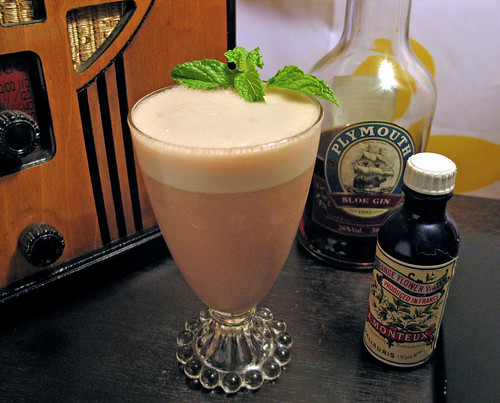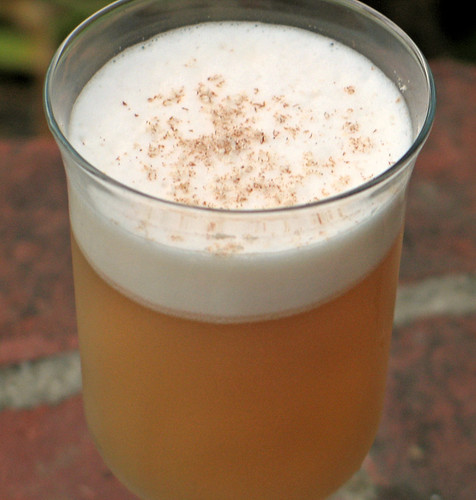Creole Fizz
This one’s a bit of a leftover from MxMo XIX, from Rick‘s mentioning getting his entry from Baker and also listing several other fascinating fizz recipes Baker had in The Gentleman’s Companion. (Speaking of which, I’ve had a tendency to skip around in that book, and I’ve actually never read it straight through from cover to cover. I oughta do that. Soon.) One of the ones Rick mentioned that really fascinated me was the Creole Fizz, which I thought I’d whip up since we’ve got some beautiful Plymouth Sloe Gin.
I mentioned this to Rick, and in shock and surprise he uttered an expletive that called into question the legitimacy of the circumstances of my birth. Such is the reaction among cocktailians when you mention this stuff, especially in the context of you having some when they don’t. (Hee hee. Sorry, didn’t mean to be a gloating bastard.) That’s because this is phenomenal stuff, redolent of the true fruit taste of the sloes, a perfect balance between sweet and tart, and none of the artifical cough syrupy flavor you get from pretty much every other sloe gin sold in this country. Fortunately he can get it the same place I got it — by mail, from Royal Mile Whiskies in Edinburgh, Scotland. They were one of the only liquor shops in the U.K. willing to ship to the U.S., and I got mine quickly and with little trouble. Unfortunately, such bottled joy comes with hideously expensive shipping costs. The 700ml bottles (odd, why not 750ml?) cost £16.13 each without VAT. Shipping will run £22, for a grand total of £54.26, or about $109.05. That’s a lot … but I think it’s worth it if you care about quality, and only the best ingredients going into your cocktails. If all I have is bottom shelf, $8.95 a bottle sloe gin, then I’d rather not use any.
Let us implore the Plymouth company to export their sloe gin to the United States! [UPDATE: Our imploring worked! Plymouth Sloe Gin is now available in limited quantities in the U.S. for about $32 a bottle.]
In the meantime, let’s make a drink. Here’s Charles H. Baker’s description from his book The Gentleman’s Companion, Vol. I: Exotic Drink Book; or, Around the World with Jigger, Beaker and Glass:
THE CREOLE FIZZ, BEING a LATTER DAY HOT WEATHER & MILDER VARIATION of the ORIGINAL NEW ORLEANS SILVER FIZZ, & EMPLOYING SLOE GIN to LEND ITS SHY BLUSH to the COLOUR SCHEME.
Lyle Saxon gave us this one way back in 1930 during a visit to New York, tellign us about his acquisition of the old French Creole House on Royal Street…. Take either the Aziz Special or the New Orleans Fizz and substitute an equal amount of good imported sloe gin, and cutting the cream down a trifle. Garnish with a sprig of fresh green mint and that’s all.
With all due apologies to Mr. Baker, I did tweak the proportions a bit. Here’s the drink as I made it last night:
The Creole Fizz
(adapted from Charles H. Baker Jr.)2 ounces Plymouth Sloe Gin.
1 ounce lemon juice.
1 ounce heavy cream.
1-1/2 teaspoons caster (superfine) sugar.
1 ounce egg white.
Soda water.
3 drops orange flower water.Combine all ingredients but the soda with plenty of ice in a shaker. Shake until you are exhausted, and your hands are stuck to the metal like Flick’s tongue in “A Christmas Story” (at least one minute, preferable two or more).
Strain into a pretty glass, top with soda and garnish with a sprig of mint.
I can’t emphasize enough how much it’s worth it to procure Plymouth Sloe Gin. The use of any sloe gin other than Plymouth will make this drink infintely inferior.









